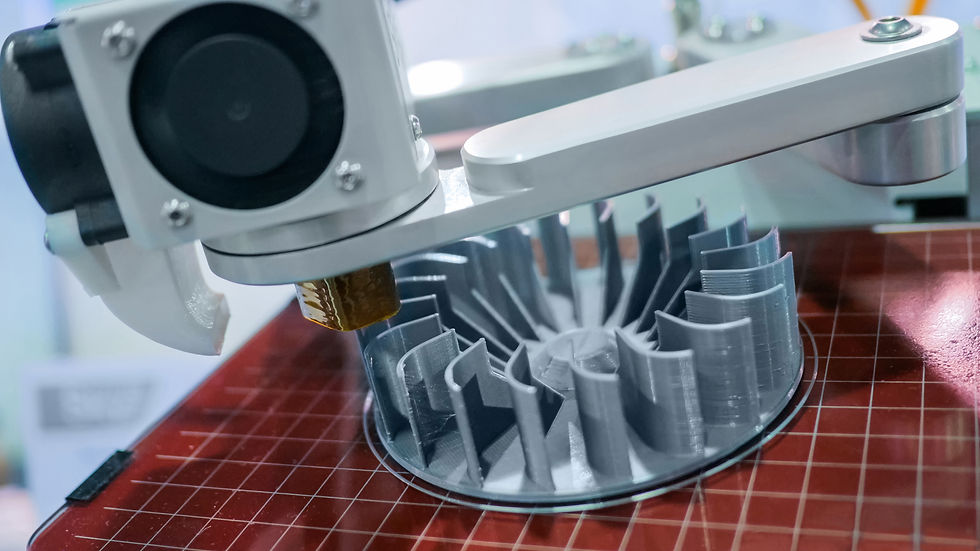Revolutionizing Manufacturing: Embracing the Unseen Potential of 3D Printing
- Dylan Brubacher
- Apr 14
- 4 min read
The manufacturing landscape is undergoing a significant shift, and 3D printing is leading the charge. This innovative technology has changed the way products are made, moving from traditional methods to a more digital and streamlined approach. With its ability to create intricate designs while minimizing waste, 3D printing is not just a passing phase; it's the foundation of tomorrow's manufacturing.
Inventive minds and enterprising companies are now transforming digital designs into tangible products in record time. In this post, we will highlight why 3D printing is becoming the preferred manufacturing method, examine its benefits, discuss challenges, and showcase how various industries are utilizing this technology to foster greater efficiency and creativity.
The Rise of Additive Manufacturing
Additive manufacturing, commonly known as 3D printing, is a revolutionary approach. Rather than removing material to create items, 3D printing adds layers of material to build products from scratch. This method reduces waste and energy usage, leading to a more sustainable manufacturing process.
As technology evolves, advancements in 3D printers and materials have expanded the applicability of this method. Industries including aerospace, automotive, and healthcare are at the forefront of adopting 3D printing, driving broader acceptance across various manufacturing arenas. For example, companies like Boeing use 3D printing for lightweight aircraft parts, significantly improving fuel efficiency.

Key Benefits of 3D Printing
Speed and Efficiency
One of the standout advantages of 3D printing is its speed. Traditional manufacturing can take weeks or months to move from design to a finished product. In contrast, 3D printing allows for rapid prototyping, enabling companies to test designs in days rather than months.
A notable example is the automotive industry. General Motors reported a 50% reduction in prototype part production time by incorporating 3D printing. This efficiency extends to low-volume production, allowing small businesses to produce customized items quickly and competitively.
Cost-Effectiveness
3D printing can save considerable money over time. By minimizing waste and eliminating the need for costly molds, manufacturers can dramatically lower production costs. Additionally, on-demand production reduces the risk of overstock and wasted inventory.
For startups, this cost-effectiveness is crucial. According to a survey, 70% of small businesses using 3D printing reported lower initial manufacturing costs. This enables innovative startups to bring ideas to market without heavy financial burdens.
Customization and Personalization
The demand for personalized products is soaring. 3D printing offers unmatched customization, allowing manufacturers to design products that meet specific customer needs without the chaos of mass production lines.
In healthcare, custom dental implants created using 3D printing are tailored to individual patients, leading to better fit and enhanced functionality. This approach boosts customer satisfaction and fosters brand loyalty, demonstrating the potential of personalization in today’s market.
Transforming Industries
Aerospace and Automotive
Innovative fields like aerospace and automotive are pioneering the adoption of 3D printing technologies. By producing high-performance parts from lightweight materials, companies improve efficiency and fuel economy.
For instance, carbon-fiber reinforced components created through 3D printing can reduce vehicle weight by up to 30%. This is a game-changer for manufacturers looking to enhance performance while meeting stringent environmental regulations.
Healthcare
In healthcare, 3D printing is revolutionizing prosthetics and implants. Custom-fitted prosthetics improve user comfort and functionality, providing patients with a better quality of life.
Furthermore, researchers are investigating the production of organs and tissues using 3D printing. This advancement could lead to breakthroughs in transplant medicine, making the dream of creating custom organs closer to reality than ever. Studies show that 3D-printed organs could reduce transplant waiting times by up to 80%, fundamentally changing patient care.
Challenges of 3D Printing
Despite its tremendous potential, 3D printing faces several challenges that must be overcome.
Material Limitations
Not every material is suitable for 3D printing. The industry continues to evolve with advancements in materials, yet challenges remain. Manufacturers often struggle to balance material properties and costs. For example, while metals like titanium are ideal for strong applications, their high cost limits their use.
Regulatory Hurdles
Fields like aerospace and healthcare encounter strict regulations that can slow the adoption of 3D printing. Compliance with safety and quality control requirements is essential, but navigating the complex regulatory environment poses challenges for manufacturers.
Looking Ahead
The future of 3D printing in manufacturing appears promising. As technology progresses, manufacturing will continue to become more responsive to consumer needs.
As industries grow accustomed to 3D printing technologies, the focus will shift towards integrating these solutions into existing manufacturing frameworks. Collaborative efforts among technology companies, material suppliers, and manufacturers will fuel innovation and hasten the adoption of 3D printing.
The Next Frontier
Ultimately, 3D printing signifies a fundamental shift in production thinking. With technology advancing, we may witness a move towards decentralized manufacturing, where goods are produced closer to the point of sale. This could significantly reduce transportation costs and environmental impacts.
In the years ahead, standing still is not an option. Manufacturers need to adapt, innovate, and embrace these technologies to stay competitive in an ever-changing market.
A New Era in Manufacturing
3D printing is not just a trend; it is charting a path toward a more efficient, sustainable, and personalized manufacturing future.
As this technology evolves, we can expect more groundbreaking innovations across various industries. Creativity and practicality will intertwine in ways we have not yet imagined.
So, stay alert and watch the horizon of manufacturing—the future is not just approaching; it is unfolding before our eyes.


.png)


